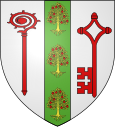Pomoy
| Pomoy | ||
|---|---|---|

|
|
|
| region | Bourgogne-Franche-Comté | |
| Department | Haute-Saône | |
| Arrondissement | Lure | |
| Canton | Lure-2 | |
| Community association | Triangle Vert | |
| Coordinates | 47 ° 40 ′ N , 6 ° 21 ′ E | |
| height | 289-393 m | |
| surface | 7.51 km 2 | |
| Residents | 210 (January 1, 2017) | |
| Population density | 28 inhabitants / km 2 | |
| Post Code | 70240 | |
| INSEE code | 70416 | |
 Look at Pomoy |
||
Pomoy is a municipality in the French department of Haute-Saône in the region Bourgogne Franche-Comté .
geography
Pomoy is located at an altitude of 309 m above sea level, eleven kilometers west of Lure and about 15 kilometers east-northeast of the city of Vesoul (as the crow flies). The village extends in the central part of the department, in the headwaters of the Ruisseau de la Prairie at the western foot of the Bois de Venet .
The area of the 7.51 km² municipal area comprises a section in the undulating landscape between the basin of Vesoul in the west and the plain of Lure in the east. The central part of the area is occupied by the basin of Pomoy, which is drained by the Ruisseau de la Prairie to the southeast via the Lauzin to the Ognon . The alluvial low lies at an average of 300 m and has a maximum width of one kilometer. To the west the terrain rises slightly to an agriculturally used plateau and up to the forest height of the Bois de Chassaigne . The northern end of the hollow forms the height of Escloupe (355 m). In the far north-west the community area extends into the lowland of the Colombine (tributary of the Durgeon ).
To the east of Pomoy rises the forest ridge of the Bois de Venet , on which the highest point of Pomoy is reached at 393. It forms the watershed against the Lure basin. From a geological and tectonic point of view, the terrain consists mainly of alternating layers of sandy-marly and calcareous sediments that were deposited during the Lias ( Lower Jurassic ). In some places in the Bois de Venet, shell limestone from the Middle Triassic comes to light.
Neighboring municipalities of Pomoy are La Creuse in the north, Genevreuille in the east, Mollans and Liévans in the south and Velleminfroy in the west.
history
Remains of a Roman traffic route point to an early inspection and probably also settlement of the area. In the Middle Ages, Pomoy belonged to the Free County of Burgundy and in it to the area of the Bailliage d'Amont . The existence of a noble family called Pomoy has been documented since the 12th century. The reign of Pomoy was dependent on the Luxeuil monastery . Together with Franche-Comté , the place finally came to France with the Peace of Nijmegen in 1678. Today Pomoy is a member of the community association Communauté de communes des Franches-Communes, which comprises 14 villages .
Attractions
The village church of Pomoy was rebuilt in the 18th century. The furnishings include a richly carved baptismal font as well as altars, paintings and statues from the time it was built. Also worth seeing are the Mairie (parish hall), a large building from the 19th century, and the village fountain, the style of which is based on antiquity.
population
| Population development | |
|---|---|
| year | Residents |
| 1962 | 190 |
| 1968 | 184 |
| 1975 | 189 |
| 1982 | 190 |
| 1990 | 152 |
| 1999 | 155 |
| 2006 | 167 |
With 210 inhabitants (January 1, 2017), Pomoy is one of the small communities in the Haute-Saône department. After the population had decreased significantly in the first half of the 20th century (494 people were still counted in 1881), slight population growth has been recorded since the beginning of the 1990s.
Economy and Infrastructure
Until well into the 20th century, Pomoy was mainly a village characterized by agriculture (arable farming, fruit growing and cattle breeding) and forestry. Today there are some local small businesses. In the last few decades the village has transformed into a residential community. Many employed people are therefore commuters who work in the larger towns in the area and in the agglomeration of Vesoul.
The village is well developed in terms of traffic. It is on the main road N19, which leads from Vesoul via Lure to Belfort . Further road connections exist with La Creuse, Mollans and Liévans.
